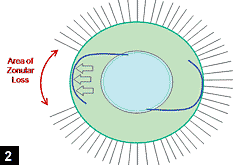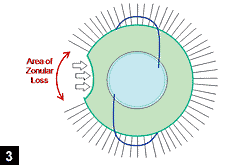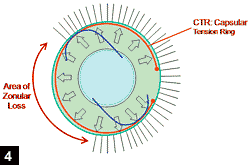Pseudoexfoliation can create challenges in cataract surgery
Because this condition is associated with glaucoma and inflammation, patients should be screened for optic nerve damage and receive preoperative NSAIDs.
Click Here to Manage Email Alerts

You notice the extensive pseudoexfoliation material on the anterior lens capsule and know that it is going to be a challenging cataract surgery (Figure 1). Pseudoexfoliation is associated with glaucoma, iris abnormalities and zonular weakness, all of which can cause difficulty during phacoemulsification. Proper preparation and early intervention can make surgery easier for the surgeon and safer for the patient.
Preoperative exam
 Uday Devgan |
Pseudoexfoliative material can be dispersed throughout the anterior segment on the anterior lens capsule in a target manner, over the zonules and ciliary processes, on the iris and in the angle of the eye (referred to as Sampaolesi’s line on gonioscopy). Any iridodonesis or phacodonesis that is noted at the slit lamp is an indication of severe zonular weakness. Iris atrophy and transillumination defects tend to result in poor dilation.
The association with glaucoma is high, and patients should be screened for optic nerve damage and treated if an elevated IOP is detected. These pseudoexfoliation patients may be more prone to inflammation, and they should receive preoperative topical nonsteroidal anti-inflammatory drugs, which will also help prevent intraoperative miosis.
Surgical technique
Step 1: Ensure adequate pupil dilation
Gentle iris stretching and viscomydriasis with mild amounts of viscoelastic can be used to achieve adequate dilation. Care should be taken to avoid excessive iris trauma and over-inflation of the anterior chamber with viscoelastic, which can cause posterior pressure on the lens and can further damage the weakened zonules. For small pupils, using flexible iris retractors is a viable option. After adequate pupil dilation, carefully check to make sure that no vitreous is prolapsing around the lens equator in areas of suspected zonule defects. A shallow anterior chamber may indicate anterior displacement of the lens-iris diaphragm because of zonular weakness.
Step 2: Capsulorrhexis creation
If the zonules are weak, capsulorrhexis creation can be difficult, as there is no counter-traction during tearing of the anterior lens capsule. This can present as a star pattern of capsular folds radiating from your instrument when piercing the anterior lens capsule and as wrinkling and looseness of the capsule.
The solution, as described by Thomas Neuhann, MD, of Germany, is to provide counter-traction via the nondominant hand using a chopper or other second instrument via the paracentesis, while using the dominant hand to perform the capsulorrhexis via the main incision. Because of the tendency for anterior capsular phimosis and further zonular stress, a large capsulorrhexis should be performed, at least 5.5 mm in diameter.
In areas of severe zonule loss, prolene iris/capsule hooks can be used to provide temporary support during the surgery. During hydrodissection it is imperative that the anterior chamber not be overfilled, as this would cause excessive zonular stress. To avoid this situation, gentle burping of the incision during hydrodissection can allow release of fluid and keep the anterior chamber at a normal pressure.
Step 3: Nucleus removal
Techniques that cause excessive posterior zonular stress, such as the grooving steps of divide-and-conquer, should be avoided. For denser nuclei, I prefer a horizontal chop technique, and for softer lenses, I prefer to prolapse the nucleus anteriorly. To avoid zonular stress, lower the bottle height, which will lower the IOP from infusion. To balance the decrease in fluid inflow, decrease the outflow of fluid via a lower peristaltic flow rate and a smaller phaco needle.
Step 4: Cortex removal
The part of the surgery that poses the greatest risk to the weak zonules is cortex removal via the irrigation and aspiration probe. Lower the flow rate and maximum vacuum settings, and be careful not to aspirate and pull on the capsular bag. Performing circumferential removal of cortex is preferred to radial stripping, as the direct stress on the zonules is less.
Capsular tension rings (CTRs) are devices that help to evenly distribute the forces over the entire capsule and can bolster a relatively large area of zonular loss. The CTR can be inserted before irrigation and aspiration, although it may make cortex removal more difficult, and therefore some surgeons prefer to insert it after the capsular bag is empty.
Step 5: IOL insertion
A three-piece foldable IOL is my lens of choice in these patients because the springy nature of the lens haptics can provide force to help support smaller areas of zonular dehiscence when placed in the capsular bag (Figure 2).
Alternatively, if sulcus placement of the IOL is desired, then the haptics should be oriented 90° away from the area of zonular loss (Figure 3). When a capsular tension ring is used, the IOL should be placed in the capsular bag, and then the orientation of the haptics is not as critical (Figure 4). If there is any doubt about the stability of the IOL, an aspheric IOL with zero-spherical aberration is the most immune to decentration.
|
|
|
|
|
Images: Devgan U |
Postoperative course
Even when complete removal of viscoelastic is performed, the pseudoexfoliation patients may have high IOPs after surgery. Administering acetylzolamide immediately after surgery and using topical glaucoma mediations in the postoperative period can control the pressure. In addition, topical use of steroids and NSAIDs is important to control inflammation, which tends to be higher in these patients.
The pseudoexfoliative process will continue after surgery, so the patient should be watched for development of glaucoma, capsular phimosis syndrome and centration of the IOL. There is a risk of the IOL-CTR-capsule complex becoming dislocated in the future, and surgical intervention should be performed before IOL stability is severely compromised.
For more information: <
- Uday Devgan, MD, FACS, is in private practice at Devgan Eye Surgery in Los Angeles, Beverly Hills, and Newport Beach, California. Dr. Devgan is Chief of Ophthalmology at Olive View UCLA Medical Center and an Associate Clinical Professor at the Jules Stein Eye Institute at the UCLA School of Medicine. Dr. Devgan can be reached at 11600 Wilshire Blvd., Suite 200, Los Angeles, CA 90025; 800-337-1969; fax: 310-388-3028; e-mail: devgan@gmail.com; Web site: www.DevganEye.com. Dr.Devgan is a consultant to Abbott Medical Optics and Bausch & Lomb, and is a stockholder in Alcon Laboratories and formerly in Advanced Medical Optics.
References:
- Fine IH, Hoffman RS, Packer M. Approach cataract surgery with care in presence of PXF. Ophthalmology Times. October 15, 2003.
- Gimbel HV, Condon GP, et al. Late in-the-bag intraocular lens dislocation: Incidence, prevention, and management. J Cataract Refract Surg; 2005: 31:2193-2204.
- Kuchle M, Viestenz A, et al. Anterior chamber depth and complications during cataract surgery in eyes with pseudoexfoliation syndrome. Am J Ophthalmol. 2000;129:281-285.




